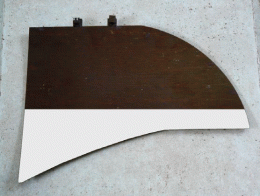February 6, 2009 feature
New Smart Material Bends Under Internal Heat Source

(PhysOrg.com) -- Scientists have developed a new smart material that can bend under the influence of an internal heat source. The material could be used as an aerodynamic flap in cars, in order to stabilize the vehicles at high speeds. Because the entire structure actively bends, the material could have advantages over actuators that need to be externally fixed to a structure.
A team of scientists from CETIM CERMAT and the Laboratoire de Physique et de Mécanique Textiles (LPMT), both in Mulhouse, France, have been working on the active structure for the past few years. In a recent study published in Smart Materials and Structures, they present the material called CBCM (controlled behavior composite material), which can bend when heated.
“The main advantage of the CBCM is that the entire structure is active, compared to classical actuators used in this kind of structures, such as shape memory alloys (SMA) or piezoelectric materials, so there is no problem of junction and connection between the actuator and the structure,” coauthor Gildas L'Hostis of LPMT told PhysOrg.com. “Moreover, the load that can carry the structure is much greater than the one carried by an SMA or piezoelectric material because the performances are not as limited by the rigidity of the composite structure. A third advantage is the simplicity of use - directly on DC current with a variator.”
The CBCM consists of thin laminate plates, inside of which are highly conductive carbon yarns that are connected to a generator and serve as the internal heating source. When the power is turned on, the current circulates in the carbon yarns and the temperature rises in the plates. The increased temperature causes the plates to bend, and the deformation can be controlled by controlling the amount of current.
The researchers experimented with two kinds of plates: “single effect” plates that can bend in one direction, and “double effect” plates that can bend in two directions. In the thin single effect plates, the temperature reached 57°C (135°F) and the structure deflected up to 15 mm. In the double effect plates (which consist of a conductive layer on one side and insulating layer on the other), the temperature reached 70°C (158°F) on the conductive side and 42°C (108°F) on the insulated side, and deflected up to 3.7 mm. While the single effect plates could deflect more, the double effect plates could lift a heavier load.
The scientists also discussed incorporating a control system into the material. By adding temperature and strain sensors to the CBCM, such a system could detect variations in its background and then adapt to the new context.
To demonstrate the new material, the researchers built a prototype of a 4-mm-thick retractable aerodynamic flap that could be used on cars for stabilization at high speeds. Unlike the existing flap, which has three joints and is moved with a jack, the smart material structure could move simply due to its thermomechanical properties.
With its advantages over other actuators and moving components, the CBCM smart material could be useful for a variety of applications. However, more research is needed to overcome some difficulties, which the scientists highlighted in their study. For instance, future research could include testing the rigidity of the plates and minimizing local overheating, possibly with the use of carbon nanotubes.
“The CBCM has already been used to manufacture an active binder for pipes,” said coauthor Karine Buet-Gautier of LPMT. “Today, some other active connectors are under study.”
More information: Drobez, H.; L’Hostis, G.; Buet Gautier, K; Laurent, F.; and Durand, B. “A new active composite.” Smart Materials and Structures 18 (2009) 205020 (7pp).
Copyright 2009 PhysOrg.com.
All rights reserved. This material may not be published, broadcast, rewritten or redistributed in whole or part without the express written permission of PhysOrg.com.





















